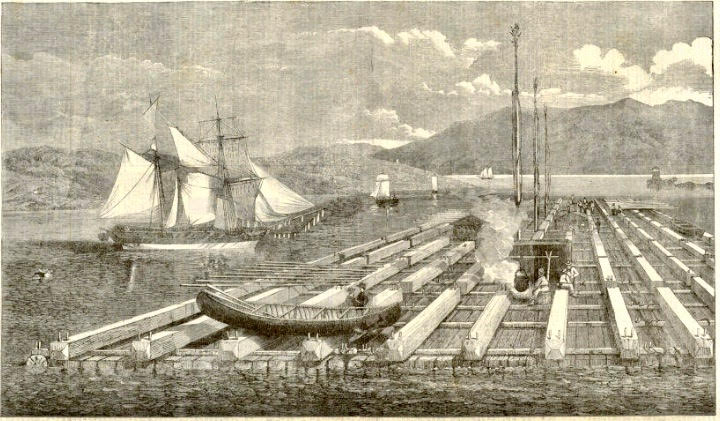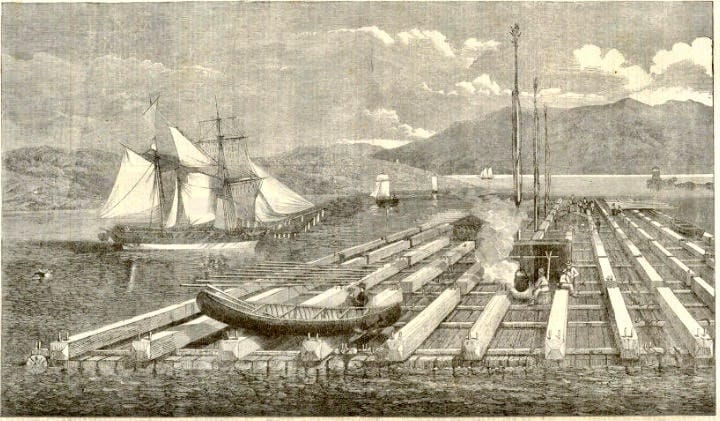Recalling the Days of Rafting on the St. Lawrence River
by: Richard Palmer
In the 1860’s, Canada’s export timber trade rose to its greatest height. Every port on Lake Ontario had its crews of raftsmen in season. H. A. Calvin, Jr. of Toronto, vividly recalled the rafting days out of Garden Island, opposite Kingston. Here, his grandfather, D. D. Calvin, established the timber and shipbuilding industry which flourished until 1914.

A very descriptive article on this business appeared in the Toronto Telegram on May 13, 1939.
The unit in rafting was a dram, a structure 60 feet wide and from 250 to 300 feet long, comprising, in the case of pine or elm ,600 to 700 pieces of timber, and in the case of oak, some 300 to 400 pieces. The timber was bound together in such a manner as to enable the dram to resist great shocks and even greater strains.
Six or eight drams were assembled into a raft, two drams wide and three or four long; the raft covered a water area greater than that of a large ocean liner. Upon the largest dram was constructed a wooden cabin, containing four sleeping bunks, a cook stove and a table. In it lived the raft foreman, cook, and an occasional guest. On another dram was a men’s cabin, with eight bunks.
Equipment for operating a raft was quite extensive, including windlass, anchors, anchor chains, sails, large oars or sweeps, pike poles, lanterns, yawl boats and the cook’s outfit. From $500 to $800 was carried upon each raft, chiefly to pay the extra men who helped in the rapids.
On the raft, on which Mr. Calvin made his boyhood trip, the crew consisted of six or eight French-Canadians and native Americans, under the supervision of a raft foreman; a cook and a head raftsman or Raft Commodore, “a broad shouldered, strongly built French-Canadian named Aime Guerin, with boldly modeled- features and a sterling loyal character.”
The day of the raft’s departure was always an exciting one, especially for a boy about to make a trip upon the raft. The ordered confusion of getting all the gear aboard, and the scent of the beautiful pine wood in the hot sun, was thrilling. The climax was reached when the side-wheel tug drew alongside the raft and passed her tow line down to the raft crew. The tug towed with about 600 feet of 12-inch line at two miles per hour, so that it might take days to reach the St. Lawrence River, from Port Britain, a hundred miles to the west.
At night, the boy lay down for the first time, in an unstable straw tick, in the little cabin. He lay awake almost the entire night, with excitement, but breakfast of eggs and fried pork was welcome at six o’clock.
The staple drink was strong tea, without sugar or milk, made by putting tea into cold water and bringing it to the boil.
After the first day’s trip through the Thousand Islands and Brockville Narrows, came the fun of putting the “A” mast up, for the square sails, and building the footholds and rowlocks for the men who row and steer the drams through the rapids. At Windmill Point, below Prescott, they tied up for the night.
Daylight, next day, saw the drams being towed through the Galop Island Pools (The Galops) and Rapide Plat Canal, with the raft in one unit. Soon they were through this smooth, but swift water, and the strong current, past historic Chrysler’s farm, to Autsville. Here extra crew and pilots for the Long Sault Rapids began to arrive, from the shore, being ferried by their friends or sons in rowboats and small craft.

These men climbed aboard the raft and discussed with the natives, of Garden Island or Port Britain, as the case might be, the probable lurking dangers of the day’s run, or the doubtful condition of the weather.
Above Cat Island, the rear dram of the raft was cast off, and left in charge of its pilot and crew. The other voyagers would see the pilot take his position, near the centre of the dram and the men their positions at their oars, ten or more across the bow and seven or so across the stern of the dram. The pilot would then wave to his men, to row to port or starboard, to straighten the course of the drifting dram and then when satisfied, with the position of the dram, call ‘halt.’ These Long Sault men were all English-speaking.
‘'Our raft, now having been towed a quarter of a mile from the separated dram, then another dram was dropped, and so on, until only the cabin dram remained in tow of the steamer. At the very brink of the rapids, the steamer’s line was cast-off her remaining charge, and she descended the rapids by herself alone. Our pilot now became totally absorbed in observation and directed the rowing with a shout and the wave of an arm and a shout to halt.
“My father’s rafts always ran the 15-mile-long, beautifully-wooded, winding channel south of Long Sault Island. At times, the dram might be traveling 20 miles per hour, at others only six miles per hour. In the swiftest places, once the dram was gripped by the strong flow of the main deep current in the proper channel, no steering was necessary and indeed in the main pitch near the foot of the rapids, oars were hauled in and the men ran aft for shelter from the breaking rollers.”
The steamer was not so selfish as she first appeared to be. She came to a standstill whenever possible behind a point of land or in an eddy, to see her charges all safely past a hazardous turn and then steam on, overtaking all the drams on her way to await their arrival in the quiet, waters below the rapids and there assemble the drams on the raft.
As “paymaster” on the trip, Mr. Calvin then paid the pilots and the oarsmen, who went ashore in small boats sent out for them at Cornwall. “Then for our pork and beans and boiled tea, and a quiet tow across Coteau Lake to tie up for the night at Saint-Zotique. During the night the pilots and crews for the Coteau Run of Rapids came aboard, this time all French-Canadians, and a very fine lot they were,” the son of Garden Island said.
“An hour before daybreak we made our departure, and almost immediately began to slip the drams. In the Coteau Run of 12 miles, there are four distinct rapids—the Coteau, the Cedars, the Split Rock, and the Cascades—but the drams remained separated throughout the entire run.
“Before entering the rapids, each devout Roman Catholic, following the example of Aime Guerin, the head raftsman, knelt at his oar to offer a prayer for a safe passage."
“The swiftest and most beautiful, and, indeed, the roughest, were the Cedars. In the Cedars the technique was to run the starboard low corner of the dram over a large bolder which retarded and altered the progress of the dram sufficiently to cause it to turn end-for-end, and in doing so, achieve a very sharp turn in the channel. In these rapids there was the distinct sensation of j-sliding downhill; moreover, the descent was sufficient to hide the hull of the steamer from view after she had shot the rapids ahead of us.
“The Coteau Run completed, drams assembled and men paid-off and gone ashore, brought us to late morning and the head of Lachine Lake."
“Very soon after we entered Lachine Lake, Indian pilots and crews from Caughnawaga came aboard a few at a time, having rowed up from the village in their ‘shallops.’ These men were our best, most alert, strong and loyal."
“In three or four hours we were across the lake. Above the C.P.R. bridge about opposite the Lachine Wharf the drams were again one by one separated, the cabin dram being towed to just below the bridge where the tow line was cast off and in a very little time we were in the swift and crooked waters of Lachine which of all the rapids was the most exciting. The danger in Lachine is caused by the natural obstructions in the river and the pronounced descent of the river bed.”
"The main channel carries you directly toward the centre of Isle Heron, which, course must be maintained until the waters part on the west shore of the Island. You therefore have to make a sharp turn to the right and almost immediately afterwards a sharp turn to the left to pass closely by the south side of the island, as there are huge submerged rocks within 200 yards to the south.
“The speed of the dram here was at least 35 miles per hour so that as you pass these rocks you saw them appear to race backward under the water in a phenomenal manner. It is here also that we got the sensation that the drams were going ‘through’ the rapids as distinct from the sensation aboard a steamer that you are going ‘over’ them.
“Near the foot of Lachine is the ‘cellar’ where two currents meet almost at right angles, in which the dram is drawn almost under the water and indeed in the case of more than one oak dram, completely under so that the men were obliged to hold on to any projection they could find.”
William Marsh lost a large raft and a small fortune by mischance in those same Lachine Rapids. At the very foot of Lachine were the huge breakers through which the dram would bend like rubber as it passed. Below Lachine the steamer was particularly busy as the drifting was very fast between the foot of the rapids and Victoria Bridge, and the assembling must be safely accomplished before they approached that towering masonry.
Great shouting's of orders inspired by the relief of another successful run, made that assembling unforgettable, and passing under that great structure within a short stone’s throw of the stone piers was grand. From Montreal to Quebec was a lazy two to four days’ trip meeting and being overtaken by huge ocean liners assuming as their right, nine-tenths of the ship channel, of a crossing treacherous Lake St. Peter and later encountering, when within 40 miles of Quebec, ocean tides.
An easterly blow with a strong flood tide often caused a good deal of anxiety and sometimes accidents, but the vast majority of the rafts were finally swung safely in on the tail of an ebb tide at the piers of the timber coves above Sillery Point, five miles west of Quebec.
In the great days of 1850 to 1870, there would be scores of sailing ships loading timber in Quebec area from ten miles above the city to some five miles below it.
Contributed by Richard Palmer
Richard F. Palmer is a retired newspaper editor and reporter, and was well known for his weekly historical columns for the “Oswego Palladium-Times”, called "On the Waterfront." His first article for TI Life was written in January 2015 and since then, he has written a half-dozen others. He is a voracious researcher, and TI Life readers benefit from his interesting findings. Click here to see some of Richard Palmer’s TI Life Articles.






Please click here if you are unable to post your comment.